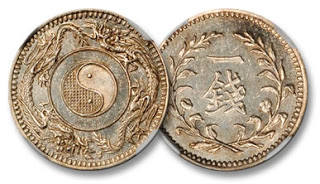
L&M-598; K-926ii; K&C-21.4; Money in the Bank (Cribb)-pg.36, figure-c. Kwan Ping Trade Coinage "Chinese-Foreign Circulating Coin," pattern in silver of un-adopted design. Patterns for this series were produced based on the Maritime Customs scale in the denominations of 1 Tael, 5 Mace, 2 Mace, 1 Mace, and 5 Candareens.
This rare and interesting series has long been the topic of speculation by numismatic authors in regards to the mint responsible for their manufacture and intended purpose (see Kann Illustrated Catalog of Chinese Coins page 324-325). Previously the Berlin Mint, The Royal Mint and the Osaka Mint have been suggested as possible places of manufacture. It is now certain the dies and patterns originated in England (the Royal Mint) as described by Joe Cribb in his reference, “Money in the Bank.”
The original design was proposed by W.F. Wade, Chinese Secretary of the British Legation in Peking. Wade’s propositions for this pattern series were relayed on October 19, 1867, via Captain Kinder to the Governor of Hong Kong. The dies for these patterns are housed in the Royal Mint where they were deposited in 1888 by Kinder’s heirs after his death. Original concept drawings of the proposed coinage design, as well as correspondences from Kinder, also survive in London. The dies and patterns were produced in England, with the intention of the circulating coinage to be struck by the Hong Kong mint.
However, the Hong Kong Mint, closed soon after, ceasing operations in April 1868. The minting machinery was then sold to the Osaka Mint in Japan. It is interesting to note that some numismatists have speculated that this issue may have been intended for use as a trade coinage with Korea. In fact that Bank of Japan has an example of the 1 Mace in its collection list as Korea. They are also listed in “The Catalog of Korean Coins and Bank Notes” as series page 171#21.1/21.4.
Although use as a Sino-Korean trade coin is plausible, no solid documentation in support of this is known. An EXTREMELY RARE and very interesting issue that merits further research as to its intended purpose. Certified and graded by NGC MS64.





